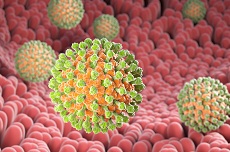Research News: Columbia University Study Shows That Coronaviruses Including COVID-19 Pathogen SARS-CoV-2 Adept At Imitating Human Immune Proteins
Source: Research News Oct 28, 2020 5 years, 1 month, 2 weeks, 6 days, 18 hours, 22 minutes ago
Research News: A new study by researchers from Columbia University Vagelos College of Physicians and Surgeons has found that coronaviruses including the SARS-CoV-2 virus that causes the COVID-19 disease are adept at imitating human immune proteins that have been implicated in severe conditions.

It has been known that viruses deploy genetically encoded strategies to co-opt host machinery and support viral replicative cycles.
In this study the team used protein structure similarity to scan for molecular mimicry, manifested by structural similarity between viral and endogenous host proteins, across thousands of cataloged viruses and hosts spanning broad ecological niches and taxonomic range, including bacteria, plants and fungi, invertebrates, and vertebrates.
Significantly the study identified over 6,000,000 instances of structural mimicry; more than 70% of viral mimics cannot be discerned through protein sequence alone.
The team demonstrated that the manner and degree to which viruses exploit molecular mimicry varies by genome size and nucleic acid type and identify
158 human proteins that are mimicked by coronaviruses, providing clues about cellular processes driving pathogenesis. The observations point to molecular mimicry as a pervasive strategy employed by viruses and indicate that the protein structure space used by a given virus is dictated by the host proteome.
The study findings were published in the journal: Cell Systems.
https://www.cell.com/cell-systems/fulltext/S2405-4712(20)30363-X?_returnURL=https%3A%2F%2Flinkinghub.elsevier.com%2Fretrieve%2Fpii%2FS240547122030363X%3Fshowall%3Dtrue#%20
Numerous plants and animals use the art of mimicry to trick their prey or predators. Viruses employ a similar strategy: Viral proteins can mimic the three-dimensional shapes of their host's proteins to trick the host into helping the virus complete its life cycle.
Lead researcher Dr Sagi Shapira, PhD, Assistant Professor of Systems Biology, Columbia University Vagelos College of Physicians and Surgeons told; Thailand Medical News, “Typically Viruses use mimicry for the same reason as plants and animals ie deception. We hypothesized that identifying viral-protein look-alikes would give us clues to the way viruses including the SARS-CoV-2 cause disease."
Dr Shapira used supercomputers In the study to search for viral mimics with a program similar to 3D facial recognition software. They scanned more than 7,000 viruses and over 4,000 hosts across Earth's ecosystems and uncovered 6 million instances of viral mimicry.
Dr Shapira added, "Mimicry is a more pervasive strategy among viruses than we ever imagined. It's used by all kinds of viruses, regardless of the size of the viral genome, how the virus replicates, or whether the virus infects bacteria, plants, insects or people."
However some types of viruses used mimicry more than others. Papilloma and retroviruses, not so much.
Coronaviruses, on the other hand, are particularly good at it an
d were found to mimic over 150 proteins, including many that control blood coagulation or activate complement-a set of immune proteins that help target pathogens for destruction and increase inflammation in the body.
Dr Shapira further added, “We thought that by mimicking the body's immune complement and coagulation proteins, coronaviruses may drive these systems into a hyperactive state and cause the pathology we see in infected patients."
Numerous human studies also support the role of viral mimics in COVID-19. Over the course of the pandemic, it has become clear that many COVID patients have coagulation problems and some are now treated with anti-coagulants and drugs that limit complement activation.
https://pubmed.ncbi.nlm.nih.gov/22930518/
In another separate study published in Nature Medicine, the Columbia researchers found evidence that functional and genetic dysregulation in immune complement and coagulation proteins are associated with severe COVID-19 disease.
https://www.nature.com/articles/s41591-020-1021-2
The study team found individuals with macular degeneration (which is associated with enhanced complement activation) were more likely to die from COVID-19, that complement and coagulation genes are more active in COVID-19 patients and that people with certain mutations in complement and coagulation genes are more likely to be hospitalized for COVID-19.
Ever since that paper first appeared this spring in a preprint, other researchers have also found links between complement and COVID severity, and several clinical trials of complement inhibitors have been initiated.
Dr Shapira says the investigation of viral protein functions and mimicry suggests that learning about underlying virus biology could be one way to gain insights into how viruses cause disease and who may be at greatest risk.
Dr Shapira commented, "Viruses have already figured out how to exploit their hosts. By studying viruses we can not only reveal fundamental principles in biology but also how they perturb cellular homeostasis and cause pathology. The hope is that one day we may be able to use this knowledge to fight back. Beyond COVID-19, the information we're gathering about how individual viral proteins work across all viruses on Earth may one day be leveraged as building blocks in medical and agricultural interventions."
In conclusion the team said, “Finally, the repertoire of structural mimics we discover opens new opportunities to identify potential mechanisms underlying autoimmune disorders of viral origin and new protein-based immune-modulatory therapeutics. For example, leveraging mimicry relationships between coronaviruses and human proteins informs about cellular targets and signaling cascades that are tuned during infection. Such knowledge can provide important clues about pathways that mediate pathology associated with infection and may point the way for designer therapeutics directed at these pathways. In addition, though beyond the scope of the current study, such knowledge may be useful in vaccine development as well as engineering of synthetic cellular operations where viral proteins are used as modules to build circuits with robust and predictable outputs. In the short term, and as highlighted by recent discovery of SARS-CoV-2 risk factors, information about virus-encoded structural mimics can help refine large-scale clinical studies and reveal determinants of immunity, susceptibility, and clinical outcome associated with human infection.”
For the latest
Research News, keep on logging to Thailand Medical News.
